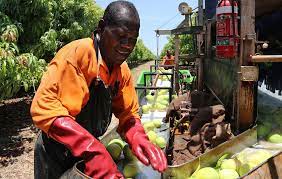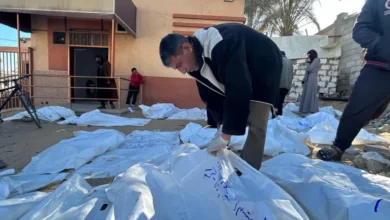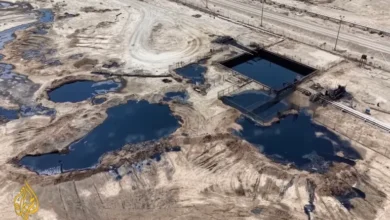Pacific Islands fear brain drain from Australia job scheme

As Pacific Island countries strive to recover from the COVID-19 pandemic, Australia and New Zealand’s seasonal job schemes are helping families regain incomes and pay for the needs of their communities.
The schemes allow thousands of Pacific Islanders to undertake agricultural and horticultural work for significantly higher wages than they would receive back home.
For Agnes from Vanuatu, an 11-month stint working in Western Australia in 2021 provided much-needed financial stability for her family during the pandemic.
“I worked on a farm, picking strawberries, in Western Australia for four months, and after that I went into hospitality working in a resort in Kununurra in the far north of the state,” Agnes, 43, who asked to be referred to by her first name only, told Al Jazeera.
“The higher income earned in Australia helped me to take care of my family in Vanuatu, it helped pay school fees and living costs.”
In Pacific Island nations, the so-called labour mobility programmes, however, provoke complicated feelings.
While providing economic opportunities to Pacific Islanders, the schemes are also blamed for draining skills and labour from the tiny, isolated nations, many of which have long struggled with low growth and high unemployment.
While Australia’s Pacific Australia Labour Mobility (PALM) scheme is officially aimed at the jobless and unskilled, some governments in the region say that significant numbers of those joining are not unemployed but in fact hold positions in sectors such as manufacturing, hospitality, tourism and healthcare. The PALM scheme, which offers Pacific Islanders the chance to work in Australia for periods of up to four years in sectors with labour shortages such as agriculture, hospitality and aged care, is expected to grow in scope amid predictions Australia could have up to two million vacant mid-skill positions by 2050.
For skilled Ni Vanuatu, the ethnic group native to Vanuatu — a collection of 80-odd islands located some 1,750km (1,080 miles) east of Australia — higher wages in Australia offer a major incentive to go overseas, said Astrid Boulekone, general manager of the Vanuatu Chamber of Commerce and Industry.
“Skilled Ni Vanuatu workers on the job are leaving their jobs to join the Pacific labour mobility program. This is further exacerbating the existing labour shortages of Ni Vanuatu workers with skills and work experience required to replace those who have left their jobs to go to Australia or New Zealand,” Boulekone told Al Jazeera. “It is affecting the capacity of local business to drive post-pandemic economic recovery in Vanuatu.”
In Samoa, which has a gross domestic product (GDP) per capita similar to that of Vietnam, the labour programmes have been similarly blamed for exacerbating workforce shortages in the local agricultural industry, according to Fuimaono Rosalia Me, a cultural adviser for the Women in Business Development non-profit.
“It has taken away our fully able people who are important for the future of families that sustain agro-businesses and help exports in agriculture commodities to overseas and niche markets, which is the backbone of our economy,” Rosalia Me told Al Jazeera.
While the Australian government says that the selection of temporary workers is made by Pacific Island nations, more than 10 percent of the male working-age populations of Tonga, Samoa and Vanuatu are believed to be employed as temporary workers in Australia and New Zealand, according to a report last year by the Australian National University’s Development Policy Unit.
Labour market imbalances are longstanding issues for Pacific Island countries. For years, population growth has outpaced economic growth in many of the islands. Limited formal sector jobs, underdeveloped private sectors, and large youth populations have combined to leave many Pacific Islanders at risk of joblessness. Only one-quarter to one-third of school-leavers in the region secure formal sector roles, according to Australia’s Lowy Institute.
In many Pacific Island countries, it is left to the informal economy to absorb up to 85 percent of working-age people, according to the Lowy Institute.
While crucial to the survival of millions across the region, the informal sector is also plagued by low wages and poor working conditions, problems which were heightened by the pandemic.
The loudest concerns have been raised in the smallest island nations, where the departure of working-age people has been felt most keenly. Among the 34,400 Pacific Islanders in temporary worker programmes in Australia and New Zealand in mid-2022, one-third were from Vanuatu, 22 percent from Samoa and 15 percent from Tonga, compared with just 10 percent from larger Fiji and Solomon Islands.
Still, governments in the region have acknowledged that labour schemes will play an important role in their recovery from the pandemic.
In countries such as Vanuatu, Solomon Islands, Samoa and Nauru, economists have predicted that GDP per capita will still be below pre-pandemic levels in 2027.
“Since the COVID-19 pandemic, labour mobility opportunities have become even more critical to help support our economic and social recovery efforts particularly at the household level,” Leatinu’u Wayne So’oialo, Samoa’s Minister of Commerce, Industry and Labour, said in an address to a regional labour mobility summit held in the capital Apia in November.










